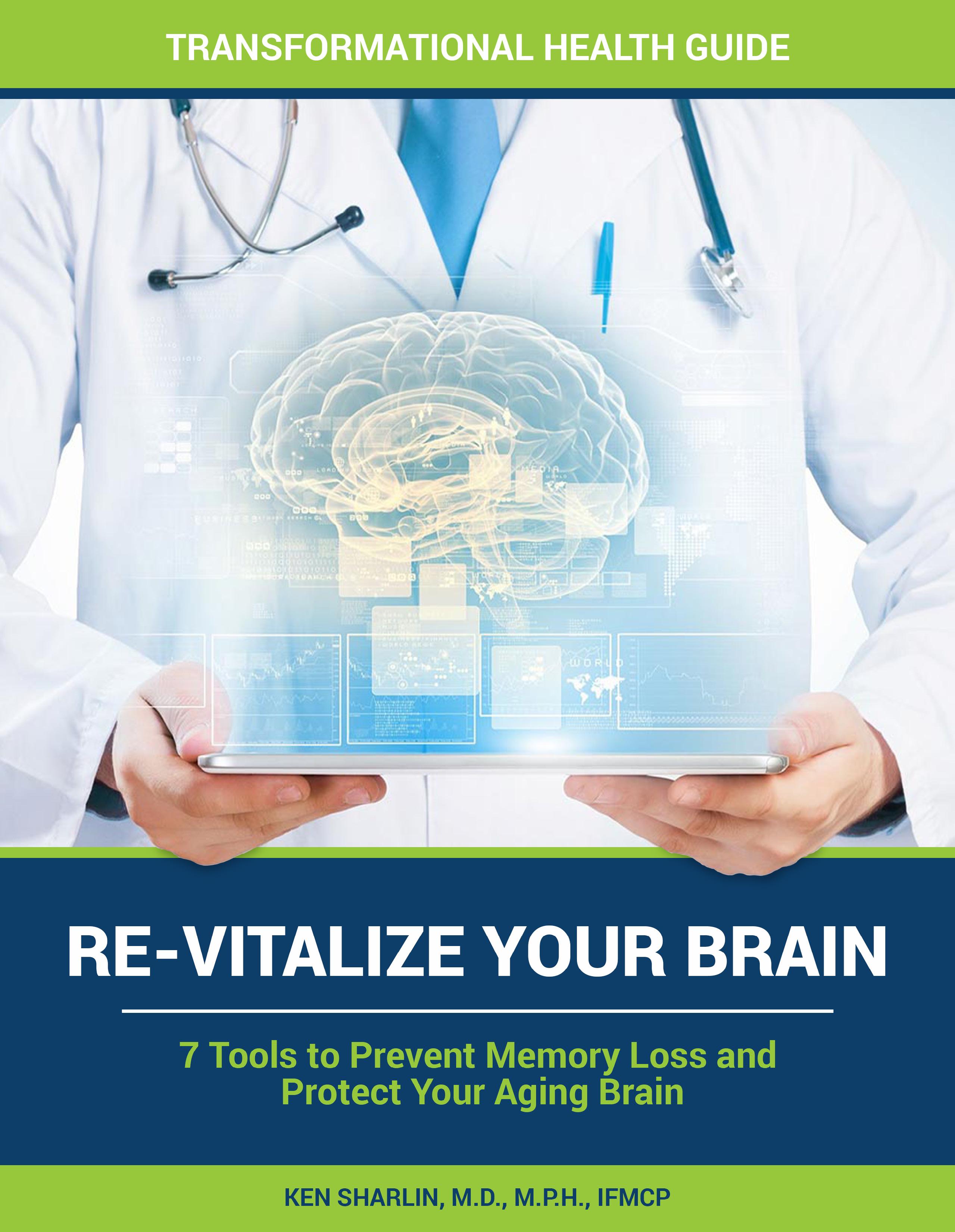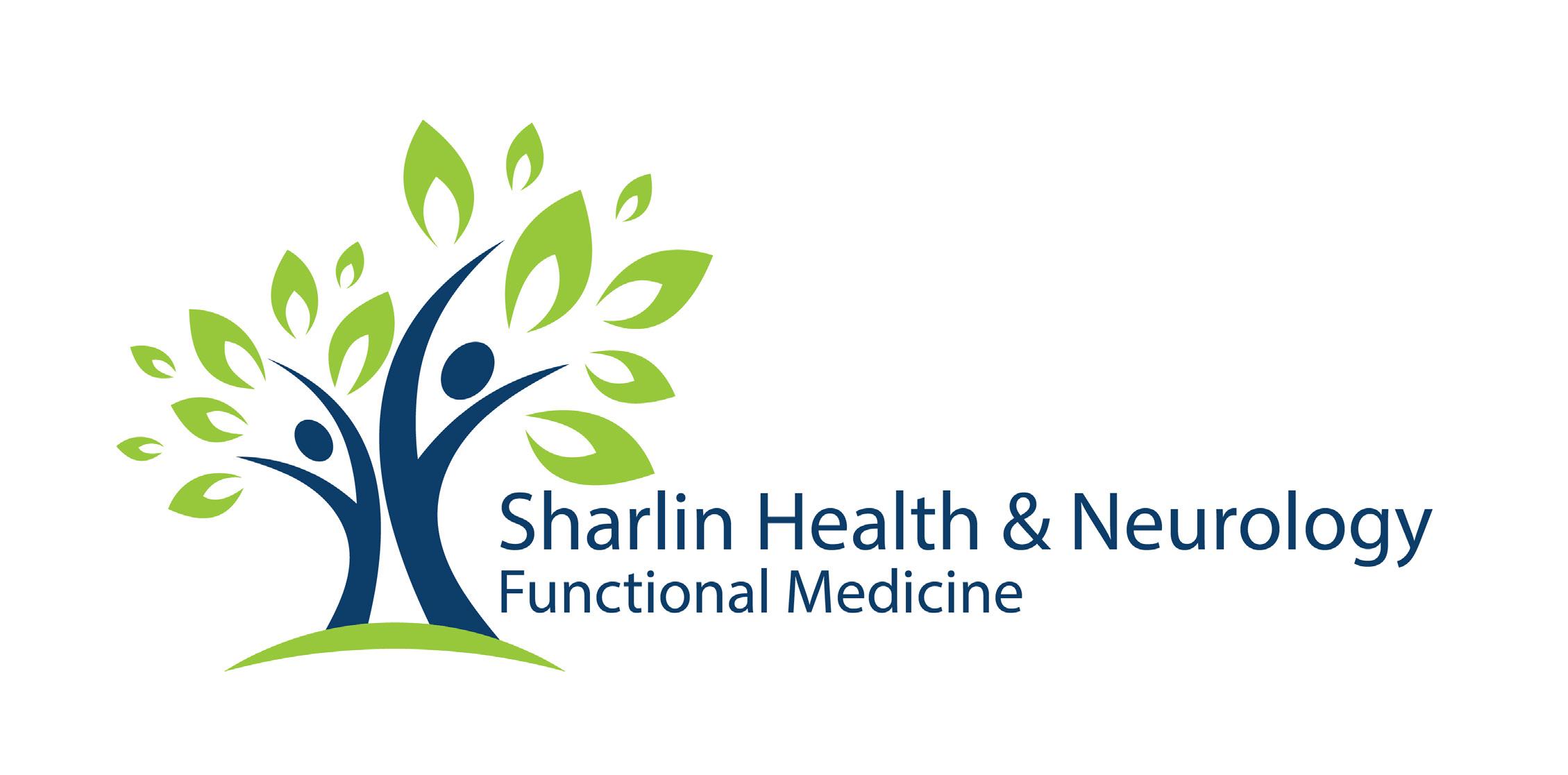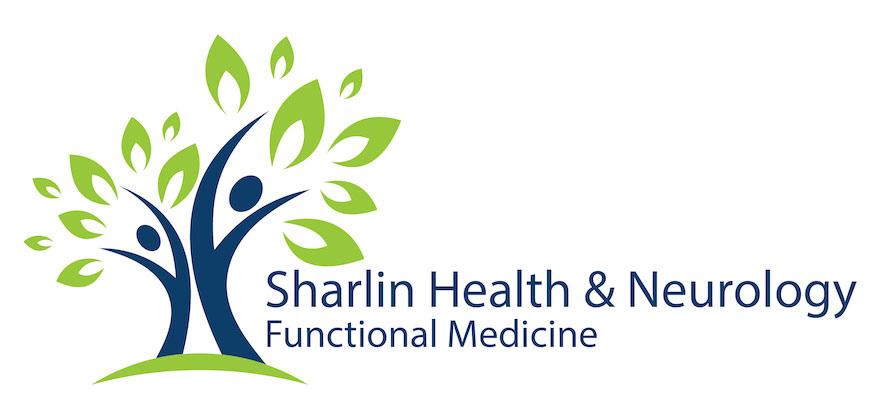

SHARLIN HEALTH AND NEUROLOGY | functionalmedicine.doctor 2 Table of Contents 1. Sleep to Repair and Restore 4 2. Eat Away Your Inflammation 7 3. Move for a Stronger Brain (and Body) 10 4. Recharge and Optimize Your Thoughts 13 5. Connect (Your Brain Needs It) 16 6. Keep Your Supplements on Target 18 7. Turn on the Technology (Where it Counts) 23 About Dr. Ken Sharlin 25
 Ken Sharlin, M.D., M.P.H., IFMCP
Ken Sharlin, M.D., M.P.H., IFMCP
SHARLIN HEALTH AND NEUROLOGY | functionalmedicine.doctor 3 YOUR HEALTH. YOUR CHOICES. OUR SOLUTIONS.

1. Sleep to Repair and Restore
Sleep is much more than a period of rest, the need to close our eyes, and the desire to feel refreshed upon awakening. It is a period of significant biological activity. Sleep plays a critical role in the digestion and absorption of nutrients. It helps maintain the balance of microbes that inhabit the gut and support our overall health.
During sleep, the brain clears toxins that have accumulated during wakefulness. These toxins build up partly due to regular metabolic activity and partly as a result of our environment. The latter may include things like heavy metals and chemicals. Sleep ensures our immune system is neither over-active (which can cause autoimmunity) or under-active (which can lead to infections) while still focused on protecting us.
Sleep is a time to repair the normal wear and tear we do to our bodies during the day. This means that certain hormones like testosterone and growth hormone are primarily secreted while we sleep, and poor sleep can be one cause of low testosterone (important for men and women) and impaired growth.
SLEEP SAFEGUARDS BRAIN CELLS BY ENSURING THAT A SUFFICIENT SUPPLY OF ANTIOXIDANTS IS AVAILABLE TO PROTECT THE MITOCHONDRIA (THE ENERGY-PRODUCING FACTORIES OF OUR CELLS).
SHARLIN HEALTH AND NEUROLOGY | functionalmedicine.doctor 4
WHEN IT COMES TO PREVENTING MEMORY LOSS, SLEEP PLAYS A CRITICAL ROLE. SLEEP IS A TIME THE BRAIN USES TO ORGANIZE AND STORE MEMORY.
Sleep influences what information gets saved in long-term memory, and what type of memory is stored, whether that is a newly acquired skill or memory related to facts and events. Tasks learned one day are better performed the next day after a good night of sleep.
Sleep improves creativity, reasoning, and higher-level insights (those “Ah-ha!” moments). Sleep affects mood. We all know that a good night of sleep gives us better control over our emotions. We just feel good after a solid night of sleep!

WHAT CAN YOU DO TO IMPROVE YOUR SLEEP?
Here are a few essential tips:
• Keep a regular sleep schedule (even on weekends) and aim for 7-8 hours of sleep per night.
• Make sure your room is as dark as you can make it. But consider allowing the sunrise to shine through your windows or get a sunrise-mimicking device to ease into wakefulness in the morning. Our brains are designed to sleep in darkness and awake with the rising sun.
• For the same reason, avoid blue light-emitting technology 1-2 hours before going to bed. This blue light is the same light that the sun emits. Our smartphones, tablets, computer screens, and televisions all put out this kind of light.
SHARLIN HEALTH AND NEUROLOGY | functionalmedicine.doctor 5
IF YOU MUST USE YOUR TECHNOLOGY IN THE EVENING, CONSIDER WEARING BLUE LIGHT BLOCKING GLASSES WHILE YOU DO. ALSO, SOME TECHNOLOGY FEATURES A NIGHT MODE THAT TURNS THE SCREEN AMBER, WHICH REDUCES MUCH OF THE BLUE LIGHT.
• Avoid aggressive exercise before bedtime. (The cortisol triggered by intense exercise triggers wakefulness.) But light stretching is okay.
• Consider a warm bath in the evening. The cooling effect of the water evaporating from our skin when we get out of the bathtub puts our bodies in “ready” mode for sleep.
• Try not to eat anything three hours before bed, and if you get up frequently during the night to urinate, consider limiting your fluids in the evening. (But hydrate well during the day!
• Avoid a nightcap. Alcohol consumed late in the evening may induce sleepiness, but it causes early-onset Rapid Eye Movement (REM) sleep followed by REM-“rebound,” which causes middle-of-the-night awakening and fragmented sleep. It may also exacerbate conditions like sleep apnea and acid reflux, which, in turn, can wake us up.
• If you are still struggling with sleep, try the following. Search your online music library (like Apple Music or Google Play) for binaural rhythms. These sound recordings put the brain waves into a state of relaxation and readiness for sleep. You must enjoy binaural rhythm recording with headphones to get the desired effect.
• Several supplements can support sleep by either telling the brain it is time to go to bed (melatonin), calming cortisol (phosphatidylserine), or increasing the brain neurotransmitter Gamma Amino Butyric Acid (GABA) associated with sleep or sleepiness. These include chamomile, valerian root, L-theanine, or GABA itself.
SHARLIN HEALTH AND NEUROLOGY | functionalmedicine.doctor 6

2. Eat Away Your Inflammation
When you eat, you provide information to your cells – essential nutrients that become your body’s building blocks. You give your brain not only the energy it needs to fuel itself day and night. You are also giving your body nature’s best medicine to heal from illness. Your choice of food is critical.
The wrong foods trigger a cascade of reactions in your body collectively referred to as inflammation. This is your body’s defense response, but just like the alarm in your home – it works great when it does what it is supposed to do, but it is a massive disruption if it gets falsely triggered and you have trouble turning it off.
The alarm company activates the system defenses unnecessarily – police, fire truck, or ambulance arrive – ready to take on an intruder, put out a fire, or take someone to the hospital – all without an actual emergency.
WHEN INFLAMMATION GETS TURNED ON IN THE BODY AND DOES NOT TURN OFF, THEN CHRONIC DISEASES OCCUR. BY PROVIDING THE OPTIMAL NUTRIENTS TO YOUR BODY, THE ALARM SYSTEM THAT IS INFLAMMATION RESERVES ITS BENEFIT FOR TIMES WHEN IT IS GENUINELY NEEDED.
SHARLIN HEALTH AND NEUROLOGY | functionalmedicine.doctor 7
MACRONUTRIENTS
Food consists of many components. It is composed of macronutrients like carbohydrates, proteins, and fats. Food also contains micronutrients, like vitamins (think B12 or folate), minerals (think magnesium, zinc, or iodine).
Another micronutrient class is called phytonutrients. These are the thousands of compounds found in plants that act as antioxidants, have anti-inflammatory properties, help remove toxins from the body, and boost the immune system.
All the macronutrients are helpful and needed. The best carbohydrates come from plants, which provide lots of insoluble fiber that feed the gut bacteria.
Nurturing the gut with such “fertilizer” ensures a healthy bacterial population, which, in turn, is essential for a healthy brain. When these bacteria feed on the fiber, they produce short-chain fatty acids, which fuel brain cells.

Carbohydrates can be used directly for fuel production in the tissues, including muscles and the brain. However, high levels of sugar can be damaging to all parts of the cell and, over time, lead to conditions like diabetes and Alzheimer’s disease.
Protein is made up of building blocks called amino acids, and the body cannot manufacture all the amino acids it needs to sustain life. It is possible to get the protein a person needs from a strictly vegetarian diet if that diet remains diverse. Still, this approach may limit the availability of crucial vitamins like B12.
On the other hand, animal protein – mainly if sourced from animals that are not given antibiotics, hormones, or exposed to different chemicals – can be an excellent protein source. These are generally grass-fed, free-range, or wild-caught species.
SOME OF THE BEST FATS ARE FOUND IN FOODS LIKE OLIVE OIL, AVOCADOS, AND OMEGA 3-RICH FATTY FISH LIKE SALMON OR MACKEREL. THESE PROVIDE US WITH THE TYPES OF FATS THAT MAKE UP CELL MEMBRANES.
SHARLIN HEALTH AND NEUROLOGY | functionalmedicine.doctor 8
They also reduce inflammation and oxidative stress, support hormone production, and are a dense form of fuel for our brain cells (which love to use fat for energy). As a bonus, they are often accompanied by critical vitamins like A, D, and E.
Unfortunately, some fats can increase inflammation to the point of tissue damage. These can be cancer-causing trans fats found in processed foods and saturated fats, which in some individuals can increase the amount of damaging cholesterol (so-called oxidized LDL or LDLp). They also tend to be foods high in omega 6 fatty acids that, when disproportionately present, can tip the scale that favors inflammation against forces that calm inflammation.
The best diet is primarily plant-based with plenty of healthy fats, moderate in the amount of protein intake (about the size of your palm with each meal), and abundant with green, leafy vegetables.
Also include colorful foods, foods low in refined or readily available sugar but high in fiber, and sulfur-rich vegetables like broccoli, cauliflower, onions, and garlic. These foods support detoxification and trigger the cell’s machinery that synthesizes our most important antioxidant called glutathione. Nuts and seeds, especially raw or spouted, are an excellent source of all these nutrients.
Spices add flavor, aroma, and many anti-inflammatory compounds. Berries and other low sugar fruit like pomegranate are rich in antioxidants. This is often referred to as a Mediterranean-style diet (or the MIND diet), and it has been shown to provide the best nutrition support for a healthy brain while it may help prevent many diseases because we believe that food-is-medicine.
Our personal experience that this type of diet can also reverse the effects of devastating conditions that affect the nervous system, including Alzheimer’s, Parkinson’s, ALS, multiple sclerosis, migraine, fatigue, fibromyalgia, and seizures, among others.
A few other rules of thumb:
• Limit grains as these tend to spike blood sugar and trigger inflammation directly or indirectly because of gut-disrupting compounds called glutenins and lectins.
• Finally, hydrate-hydrate-hydrate. This means drinking about half your weight of clean, filtered water as measured in ounces daily. Teas and infused waters are also a great alternative but avoid soda, sports, and energy drinks altogether.
SHARLIN HEALTH AND NEUROLOGY | functionalmedicine.doctor 9

3. Move for a Stronger Brain (and Body)
Most of the conversation about exercise for the brain is about doing crossword puzzles and learning a new language. While these things can help upgrade your mind’s software, they don’t do much for the hardware. If you’ve ever tried to run the latest version of your preferred operating system on an old computer, you know the performance and output are far less than optimal. It may not even work at all! That’s why it is essential to redefine exercise for the brain to include training for the body.
The foundation of an exercise program for optimal results for the brain and body includes three essential parts: cardiovascular exercise (“cardio”), resistance-oriented functional movement training, and the integration of cognitive activities with movement. While each element is necessary, think of them as stacking on top of each other – like a pyramid.
CARDIO
This is your foundation. Your brain is an organ, and like the heart or kidneys, it depends on good blood flow to function properly. With its high metabolism, the brain requires more oxygen and glucose than other parts of the body to nourish the cells that are present and grow new nerve cells.
SHARLIN HEALTH AND NEUROLOGY | functionalmedicine.doctor 10
As if that wasn’t reason enough to tickle your interest, research also shows that cardio reduces inflammation and stress, and stimulates brain-derived neurotrophic factor (BDNF). BDNF is a protein that is like fertilizer for our brains and is critical in developing new brain cells. Cardiovascular exercise has also been shown to boost the hippocampus’s size, the part of the brain that is responsible for learning and memory.
You’ll want to put a little oomph into it. If you don’t have a heart rate monitor or smartwatch, use the Talk Test. If you have enough breath to carry on a conversation but not sing Happy Birthday to someone, you are working at a moderate intensity. If you can talk, but you have to catch a breath every few words, you are working at a vigorous intensity.
RESISTANCE TRAINING
This is the middle layer of the pyramid. Resistance training is essential for two reasons. First, research has shown that resistance training can improve reasoning and memory.
As with cardio, lifting weights and other forms of resistance training also improves the body’s ability to grow new nerve cells and make new connections in the brain. Second, resistance training is key to retaining muscle mass, improving balance, and maintaining the ability to perform daily living activities like climbing stairs.
Your most significant resistance training benefit comes from doing closed-circuit resistance training activities. That means getting off weight machines at the gym and challenging your body to move in multiple planes of motion, as we do in real life.
In contrast to sitting on a leg extension machine, pushing a platform back and forth (movements that repeat one specific pattern and are firmly fixed in one plane of motion), an open circuit, like a squat, requires almost every muscle in the lower body to work as well as muscles to grip a dumbbell (or two) and balance in space. Your brain has to remember the specific sequence of movements that take you from the bottom of the move to the top.
To sum up, if you’re new to this type of training, your next action step is to do two days a week of resistance. Ideally, in those two days, you would do exercises focused on the seven functional movement patterns (squat, lunge, push, pull, hinge, single-leg, and twist) and core work.
SHARLIN HEALTH AND NEUROLOGY | functionalmedicine.doctor 11
If you’re new to resistance training and aren’t sure how to safely do these exercises, seek the advice of a certified personal trainer. A certified fitness professional can help develop a more personal plan and make sure you’re working out safely and effectively.
COGNITIVE
Once you’ve put your base in place, it’s time to put on the top of the pyramid. This final layer is what helps you optimize results for a combined benefit to the brain and body. Step 3 is making sure your exercise plan challenges you to learn something new.
Your body is smart. It learns how to do something as efficiently as possible in a relatively short time. If you’ve been doing the same workout for months (or years), you probably do not get all the benefits compared to when you first started.
Your body is going through the motions with minimal energy expenditure. If you’re doing the same round of bicep curls and overhead presses, the movements become old hat, and your brain can quickly check out, too.
To remember a new routine requires your brain to learn a new pattern. Your body has to recruit different muscles in different ways. If you’re new to resistance training, learning how to do a proper squat or compound movement, like a squat-to-overhead press, can be both a challenge to the brain and body. This new routine and a new way of resistance training may be all you need to trigger new brain cells’ growth.
If you’re not new to resistance training, you have two possible action steps. The first step is to try unilateral training. That means do your squat to overhead press one arm at a time or do a single-arm chest press. This requires your brain and body to do something you know in a new way, and in doing so, you recruit new muscles and create new neural pathways. The second step is to add a cognitive skill. A simple place to start is counting your repetitions by 2 (2,4,6,8) instead of the standard 1,2,3,4. Adding brain training on top of physical exercise multiplies the effect.
THAT’S IT. YOU NOW KNOW THE CRITICAL STEPS OF AN UPGRADE TO BOTH THE HARDWARE AND THE SOFTWARE, LEADING TO A BETTER BODY AND A HEALTHIER, MORE RESILIENT BRAIN.
SHARLIN HEALTH AND NEUROLOGY | functionalmedicine.doctor 12

4. Recharge and Optimize Your Thoughts
In our minds, the term “lifestyle” is often associated with food and exercise. Beyond what we’ve shared so far, there are other factors to consider when putting the critical pieces together that will ultimately result in the YOU you’ve always wanted – vibrant and resilient.
When you identify your life through the lens of illness, you define it by an anticipated downhill course of what will come next until it controls all thoughts and actions completely. It does not have to be this way.
Thoughts can be so satisfying. Inside your mind, you can have conversations you are unwilling to speak, explore new ideas and dream of the future, figure out a new way to solve a pesky problem. Thoughts can either comfort or put you in the sympathetic state of “flight, flight, or freeze.”
THE CONSCIOUS MIND IS THE DIRECTOR OF YOUR MOVIE, THE AUTHOR OF YOUR BOOK, OR THE CAPTAIN OF THE SHIP – WHATEVER METAPHOR SPEAKS TO YOU. THE SUBCONSCIOUS MIND – OR THE CREW – WILL TAKE DIRECTION FROM THE CONSCIOUS MIND AND GIVE YOU WHAT YOU ASK FOR.
SHARLIN HEALTH AND NEUROLOGY | functionalmedicine.doctor 13
You can see how important it is for you to choose your thoughts purposefully. If you do not take control to manage your thoughts, it is much like an unsupervised child taking over the situation: lots of drama and tantrums, and eventually exhaustion.
The primary function of the unconscious mind is to keep you alive and whole. It wants to follow instructions from your conscious mind and the moral code you were taught as a child. The unconscious mind stores all of your memories and emotions, and it runs your body systems. It has detailed awareness of your body in the here and now but, more importantly, what your body would be like in perfect health.
It receives all external data from the five senses and filters it before presenting that information to your conscious mind for further instructions. The unconscious mind regulates your energy depending on how it perceives your physical and emotional data and the direction it receives from your conscious mind.
With repeated and purposeful direction from the conscious mind, habits are also formed and maintained in the unconscious. However, conflicting guidance from the conscious mind decreases the efficiency of habit formation.
The unconscious mind senses symbols and metaphors, so conscious thought needs to be specific in its direction. For example, if you think, “I don’t want to be fat,” your mind sees a symbol of a heavy body, and your unconscious mind will give you that picture. It is essential to have a clear and moving image in your mind of the future you wish to achieve.

REGENERATIVE EMOTIONS
The unconscious mind also works with emotions. Purposely choosing regenerative emotions like gratitude, love, hope, peacefulness, vitality, and zest will not only direct the unconscious but guide the heart to regulate with coherence.
SHARLIN HEALTH AND NEUROLOGY | functionalmedicine.doctor 14
The heart operates by increasing the heart rate as you breathe in and decreasing the heart rate as you exhale. This is called heart rate variability. The greater the variability and the more regular this occurs, the healthier you will feel.
YOU CAN PRACTICE HEART COHERENCE BY BREATHING IN A DEEP AND REGULAR PATTERN WHILE EXPERIENCING A REGENERATIVE EMOTION.
Daily practice of heart coherence will increase your stress resilience, much like how a cell phone loses battery power when too many apps are open at once. Closing the apps and plugging it in will fill the battery. When you have a full battery by controlling the thoughts and emotions you choose, you have the strength and resilience to handle stressful situations with ease.
Letting your mind worry and chew on negative thoughts and feelings tells your body that you are not safe. The sympathetic part of the autonomic nervous system responds by pushing out hormones and neurotransmitters like cortisol to be in a state of alert. This eventually drains your body systems of energy.
Using your conscious mind to direct your body with positive thoughts and emotions will energize your battery by creating healing hormones and neurotransmitter chemicals like DHEA. These chemicals will let your body rest and repair and allow you to achieve the healthy body you see in your clear and moving picture of the future.
THE QUICK COHERENCE TECHNIQUE®
There are several strategies you can use to shift your energy toward growth and revitalization. We especially like at Sharlin Health and Neurology the Quick Coherence Technique® developed by our friends at The Heartmath Institute.
The Quick Coherence Technique® helps you create a coherent state, offering access to your heart’s intelligence. It uses the power of your heart to balance thoughts and emotions, allowing you to achieve a neutral, poised state for clear thinking. It is a powerful technique that connects you with your energetic heart zone to release stress, balance your emotions, and feel better fast.
YOU CAN LEARN MORE ABOUT THE QUICK COHERENCE TECHNIQUE® HERE.
SHARLIN HEALTH AND NEUROLOGY | functionalmedicine.doctor 15

5. Connect (Your Brain Needs It)
Once you’ve mastered the ability to recharge and optimize your thoughts, the next critical step is to connect with others you know and trust, and who can reflect the same positive “can do” energy that you put out. It’s infectious – in a good way. Social isolation is a significant health problem for older adults. Not only is loneliness a risk factor for Alzheimer’s disease and depression, but social isolation will virtually guarantee that those affected by these conditions will deteriorate much more quickly.
Family, friendships, and community are part of who we are and what we do. At the most primitive level, our hunter-gatherer ancestors were more likely to find food, water, safety, and shelter, and reproduce if they were among the company of others. There is safety in numbers. This has ensured our species success through the millennia.
Not surprisingly, then, according to Dr. Matthew Lieberman, “the same brain regions that register the distress of physical pain are also active in situations where we experience social pain, such as rejection or exclusion. Social pain may not be pleasant at the moment, but we would be lost without it.” It’s a call to action. It’s why Lieberman titled his book, Why Our Brains are Wired to Connect (Crown, 2013).
THE BRAIN FUNCTIONS MORE OPTIMALLY WHEN WE CONNECT, AND WE ARE REWARDED FOR DOING SO.
SHARLIN HEALTH AND NEUROLOGY | functionalmedicine.doctor 16
Oxytocin, a hormone that comes from the brain region known as the hypothalamus and pituitary glands, plays a critical role in life, bonding, positive, trusting relationships, maternal care, and sexual behavior, reducing anxiety and depression. It turns out that oxytocin has both anti-inflammatory and antioxidant effects.
WHAT CAN YOU DO TO CONNECT?
Here are a few ideas:
• Make it a daily practice to hug at least one person close to you 60 seconds every day. (Make sure you have permission.) The “love” reward – Oxytocin – will increase for both of you.
• Set aside specific times during the day when the phones, tablets, computers, and television are turned off and have a real face-to-face conversation, such as at mealtime. Ask meaningful questions or have thoughtful discussions like, “tell me what was the best part of your day so far?” or “what was the most challenging for you, and what solution did you discover to help you through it?” At Sharlin Health and Neurology, we begin our weekly staff meetings with our personal and business best.
• Join a club – crafting, wine, sports, dance, book, or gardener’s club – whatever excites you.
• Take a class that invites interaction and join a study group. Learning and socialization are a great combination!
• Attend a house of faith that calls to you and get to know your extended family there.
• Have a regular telephone date with someone you love who is far away, a dear family member or friend.
• Connect with your purpose or personal vision every morning.
WHATEVER YOU CHOOSE, FILL YOUR LIFE WITH RICH, MEANINGFUL, AND NONJUDGMENTAL INTERACTION. IT’S EASY TO WITHDRAW AFTER A DIAGNOSIS, AND THAT IS THE WORST THING YOU CAN DO FOR YOUR BRAINS AND OVERALL HEALTH. REAL FRIENDS DO NOT JUDGE. DON’T BE AFRAID. JUST GET OUT AND DO IT!
SHARLIN HEALTH AND NEUROLOGY | functionalmedicine.doctor 17

6. Keep Your Supplements on Target
In The Healthy Brain Toolbox, the chapter covering supplements (Chapter 13) is intentionally placed toward the book’s end. This is because the message is that lifestyle is medicine. For the same reason, this section here, which covers supplements, is positioned toward the end.
LONG-TERM RESILIENT HEALTH IS NEVER FOUND IN A PILL.
With that thought, we can share a few things after years of deep-diving into holistic, integrative neurology when it comes to supplements. Participants in the Brain Tune Up! Program undergo a battery of blood tests during their first visit (and later repeated during the fourth visit to track progress).
These tests measure vitamins, minerals, electrolytes, detoxification markers, hormones, inflammatory markers, antioxidants, and a handful of critical genes. They also investigate the presence of chronic infections and environmental toxins, including heavy metals.
TO BE CLEAR, IT IS ALWAYS BEST TO KNOW EXACTLY WHAT YOU NEED WHEN CHOOSING THE RIGHT SUPPLEMENTS.
SHARLIN HEALTH AND NEUROLOGY | functionalmedicine.doctor 18
However, Re-vitalize Your Brain is intended as a stand-alone guide and does not require blood tests to utilize the seven tools to prevent memory loss and protect your aging brain. In this simple guide, it is best to think of the use of supplements where the aim is to restore optimal levels of these nutrients.
What we have noticed is that even when a person has the most conscientious approach to food, our food supply falls short for a variety of reasons. This includes soil depleted of minerals and microbes, inadequate intake (even when the individual food choices are acceptable), and insufficient absorption through the digestive tract.
ONE LAST WARNING. THE SUPPLEMENT INDUSTRY IS NOTORIOUSLY POORLY REGULATED. SHORT CUTS TO SAVE ON MANUFACTURING COSTS CAN, IN TURN, COST YOU TIME AND MONEY AND DO NOTHING TO SUPPORT YOUR BRAIN HEALTH.
Invest in yourself by using only high-quality physician grade supplements (nutraceuticals) certified by NSF (nsf.org) and GMP (Good Manufacturing Practices). All the supplements available at Sharlin Health and Neurology – see Dr. Sharlin’s exciting line of brain supporting nutrients – fall into this category.
At Sharlin Health and Neurology, there are a few supplements that patients almost always need, based on testing.
OMEGA 3
A high-quality omega 3 fish oil supplement, consisting of at least 840 mg of DHA and EPA combined.

Research has shown that DHA is involved in the brain’s development and normal function, including the light-receiving portion of the eye, called the retina. At the same time, EPA plays a vital role in mediating inflammatory pathways. Supplementation with a direct source of EPA and DHA, like fish oil, will improve the omega-6 to omega-3 ratio and provide nutritional support for a healthy brain, including mood enhancement and increased mental focus eye function while promoting a normal inflammatory response.
See Dr. Sharlin’s Brain Omega
SHARLIN HEALTH AND NEUROLOGY | functionalmedicine.doctor 19
PROBIOTICS
A probiotic should contain a blend of carefully chosen microbes in concentrations sufficient to have an impact on gut microbial diversity and balance strengthens the gutimmune barrier. it also contributes to the production of short-chain fatty acids (fuel for the brain) and other critical nutrients, neurotransmitters, a robust immune system, and improve overall bowel function.
See Dr. Sharlin’s Brain Biotic
VITAMIN D
Vitamin D, in the form of D3 5,000 IU daily. Taking this a step further, consider a vitamin D in combination with vitamin A and K2.
Vitamin A is a potent signaling molecule in the brains of growing and adult animals. It regulates numerous gene products and modulates neurogenesis, neuronal survival, and synaptic plasticity.
Whereas K2 not only supports the deposition of calcium into bone and helps protect against cardiovascular events, it promotes remyelination of nerve cells in the brain.
See Dr. Sharlin’s ADK
ZINC
Zinc, typically supplemented in the range of 30 to 50 mg daily, is critical to normal brain function. It plays a vital role in axonal and synaptic transmission and is necessary for nucleic acid metabolism and brain tubulin growth and phosphorylation.
Lack of zinc has been implicated in impaired DNA, RNA, and protein synthesis during brain development. Alterations in zinc have been suggested as a critical factor in developing several neuropsychiatric disorders, including depression.
Finally, a growing body of evidence indicates a deficiency of zinc leads to an increased risk of developing neurological disorders.
SHARLIN HEALTH AND NEUROLOGY | functionalmedicine.doctor 20
It has been shown to affect neurogenesis and increase neurons’ programmed cell death, leading to learning and memory deficits.
It may not be surprising that altered zinc balance is a risk factor for Alzheimer’s disease, aging, and other neurodegenerative disorders.
See Dr. Sharlin’s Neuro Zinc Pro
MAGNESIUM
Magnesium plays a vital role in the brain and nervous system function. From a neurological standpoint, magnesium is essential for nerve transmission and neuromuscular conduction.
It also functions in a protective role against excessive excitation, leading to neuronal cell death (excitotoxicity), and has been implicated in multiple neurological disorders.
Magnesium status is positively associated with stress levels, with both stress and low magnesium potentiating each other’s harmful effects.
LOW MAGNESIUM HAS BEEN ASSOCIATED WITH STRESSFUL CONDITIONS SUCH AS MIGRAINE, FIBROMYALGIA, AND CHRONIC FATIGUE SYNDROME.
Lastly, Magnesium stimulates electrical activity in the brain and aids the brain’s ability to process information, helps memory, and sleep.
See Dr. Sharlin’s Neuro Mag Pro
ACTIVATED B-VITAMINS
Activated or “methylated” B-vitamins.
Methylation is a vitamin-requiring biochemical process in the body that is critical for supporting many aspects of mental and physical health, including regulating gene expression.
SHARLIN HEALTH AND NEUROLOGY | functionalmedicine.doctor 21
Methylation occurs billions of times every second and helps the body to repair DNA continually. When methylation processes in the body slow down, an increase in DNA strand breakage can occur.
In addition to maintaining DNA repair, methylation reactions help maintain optimal neurotransmitter production, homocysteine balance for cardiovascular health, and the recycling of molecules required for detoxification and supporting a healthy inflammatory response.
Methylation is also required for proper energy metabolism, immune, and nerve cell function. Proper methylation can be inhibited by genetic variations in the enzymes that activate critical B-vitamins, such as MTHFR.
See Dr. Sharlin’s Neuro-Active B, which contains the forms of these vitamins that bypass these enzymes because the B-vitamins are already activated.

SHARLIN HEALTH AND NEUROLOGY | functionalmedicine.doctor 22

7. Turn on the Technology (Where it Counts)
The short section here focuses on how you can use technology in ways that help.
Here are some things to consider:
• Do you wear a smartwatch that helps you track your sleep, diet, exercise, water intake, or remind you to take a minute several times a day and focus on your breath?
• Have you explored a meditation app on your phone?
• Have you experienced the healing power of sound? Check out binaural beats (many free recordings available through the various online music services).
These recordings must be enjoyed using headphones or earbuds and synchronize nerve cells in your brain to send electrical messages at the same rate as the rhythmic beat it perceives. These electrical messages promote relaxation, sleep, focus, learning, healing, and love.
• Are you an athlete or need to up your game when it comes to fine motor skills?
SHARLIN HEALTH AND NEUROLOGY | functionalmedicine.doctor 23
Did you know low-level electrical pulses applied to the brain can improve chronic pain, reduce anxiety, and reverse insomnia? These are some of the benefits explored using transcranial direct and transcranial alternating current stimulation.
• Single-pulse transcranial magnetic stimulation has been shown to help migraines. In contrast, other pulsed electromagnetic field devices have been used to improve sleep, meditation, provide deep relaxation, improved focus, energy, vitality, and reduce pain.
THESE ARE JUST A FEW IDEAS. ALTHOUGH SPECIFIC BRANDS ARE NOT REFERENCED IN THIS SECTION, THE TECHNOLOGIES ARE WIDELY AVAILABLE TO CONSUMERS AND, FOR THE MOST PART, DO NOT REQUIRE A NOTE FROM A DOCTOR TO TRY THEM OUT.
On behalf of my team and I at Sharlin Health and Neurology, we hope you’ve found our short e-book helpful and that at least some small part has added to your life, and your brain, in a positive and re-vitalizing way.
SHARLIN HEALTH AND NEUROLOGY | functionalmedicine.doctor 24
If you would like to learn more about how we help, please visit our website at functionalmedicine.doctor If you are ready to book an appointment, click here or give us a call at 417-485-4330


About Dr. Ken Sharlin
Ken Sharlin, M.D., M.P.H., IFMCP, is a board-certified neurologist, consultant, functional medicine practitioner, Assistant Clinical Professor, researcher, author, and speaker.
His medical degrees are from Emory University, The University of Virginia, and Vanderbilt University. His functional medicine certification is through The Institute for Functional Medicine.
He is the author of the #1 best-seller The Healthy Brain Toolbox: Neurologist-Proven Strategies to Improve Memory Loss and Protect Your Aging Brain and co-author of Neurishment: The Brain Tune Up Food Guide.
Dr. Sharlin is also a significant contributor to Reversal of Cognitive Decline: 100 Patients, found in the peer-reviewed Journal of Alzheimer’s & Parkinsonism. He has been the primary investigator in several pharma-sponsored clinical trials that have helped bring new therapeutics to market.
DR. SHARLIN PRACTICES GENERAL NEUROLOGY AND DIRECTS HIS FUNCTIONAL MEDICINE PROGRAM, BRAIN TUNE UP!, IN OZARK, MO.
SHARLIN HEALTH AND NEUROLOGY | functionalmedicine.doctor 25


 Ken Sharlin, M.D., M.P.H., IFMCP
Ken Sharlin, M.D., M.P.H., IFMCP














